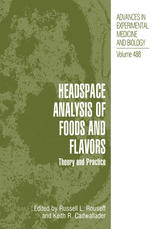

Most ebook files are in PDF format, so you can easily read them using various software such as Foxit Reader or directly on the Google Chrome browser.
Some ebook files are released by publishers in other formats such as .awz, .mobi, .epub, .fb2, etc. You may need to install specific software to read these formats on mobile/PC, such as Calibre.
Please read the tutorial at this link: https://ebookbell.com/faq
We offer FREE conversion to the popular formats you request; however, this may take some time. Therefore, right after payment, please email us, and we will try to provide the service as quickly as possible.
For some exceptional file formats or broken links (if any), please refrain from opening any disputes. Instead, email us first, and we will try to assist within a maximum of 6 hours.
EbookBell Team

4.3
18 reviewsHeadspace gas analysis is an analytical technique that has been successfully applied to food flavors for over 20 years but has experienced a resurgence of interest and innovation in recent years. In its truest form, headspace analysis represents the direct collection and analysis of the mixture of vapors in the space immediately above a food or beverage. The technique offers several advantages for workers interested in how a product smells and ultimately tastes. It offers the advantages of speed, simplicity, and, more importantly, represents the aroma profile a consumer is likely to experience just before consuming the product. Since only volatile components are collected, the sample is totally free of nonvolatile residues which commonly plague comparison liquid-liquid extracts of the same product.
This is the first book devoted to headspace analysis in foods and beverages in more than 20 years. The publication contains chapters on the basic theory of headspace analysis, as well as the theory and application of newly developed headspace techniques, such as solid phase micro extraction, SPME and electronic noses. New concentrating and desorption techniques are described in addition to a raft of food applications including tomato and citrus juices, alcoholic beverages, baguettes, dairy products, lipids, grill flavoring, baked potato, and meat. Chapters on off-flavors as well as aroma-food matrix interactions are also included.
"This is the bible of headspace analysis. If you are involved in, or planning on becoming involved, or want to learn more about, this incredible subject , then buy this book immediately!"
– Aubrey Parsons, governing council member, International Union for Food Science and Technology